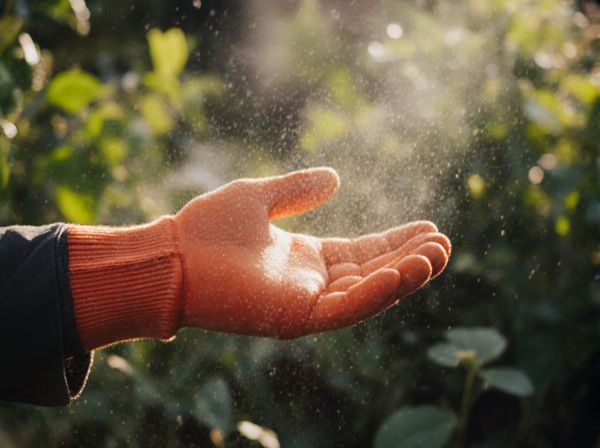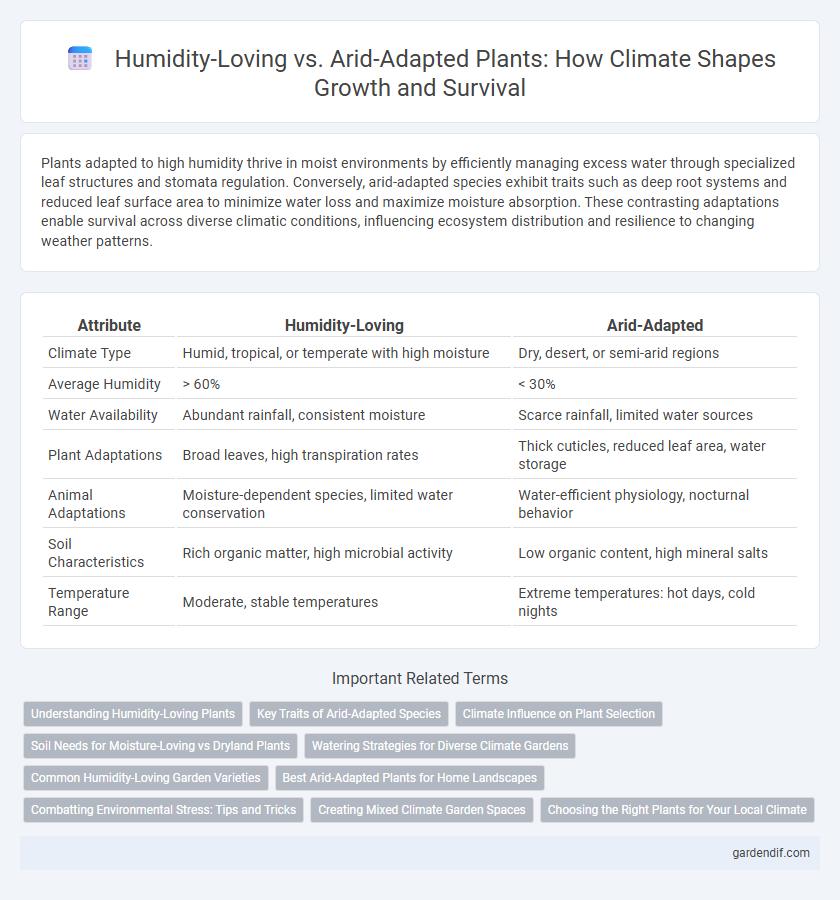
Humidity-loving vs Arid-adapted Illustration
Plants adapted to high humidity thrive in moist environments by efficiently managing excess water through specialized leaf structures and stomata regulation. Conversely, arid-adapted species exhibit traits such as deep root systems and reduced leaf surface area to minimize water loss and maximize moisture absorption. These contrasting adaptations enable survival across diverse climatic conditions, influencing ecosystem distribution and resilience to changing weather patterns.
Table of Comparison
| Attribute | Humidity-Loving | Arid-Adapted |
|---|---|---|
| Climate Type | Humid, tropical, or temperate with high moisture | Dry, desert, or semi-arid regions |
| Average Humidity | > 60% | < 30% |
| Water Availability | Abundant rainfall, consistent moisture | Scarce rainfall, limited water sources |
| Plant Adaptations | Broad leaves, high transpiration rates | Thick cuticles, reduced leaf area, water storage |
| Animal Adaptations | Moisture-dependent species, limited water conservation | Water-efficient physiology, nocturnal behavior |
| Soil Characteristics | Rich organic matter, high microbial activity | Low organic content, high mineral salts |
| Temperature Range | Moderate, stable temperatures | Extreme temperatures: hot days, cold nights |
Understanding Humidity-Loving Plants
Humidity-loving plants thrive in environments with consistently high moisture levels, often found in tropical rainforests where humidity exceeds 70%. These plants have adapted to absorb water efficiently through aerial roots and large leaf surfaces that minimize water loss. Understanding their moisture requirements and root structures is essential for cultivating healthy humidity-loving species in controlled environments.
Key Traits of Arid-Adapted Species
Arid-adapted species exhibit key traits such as specialized root systems that maximize water uptake and minimize evaporation loss, enabling survival in environments with scarce moisture. Their leaves often have thick cuticles, reduced surface areas, or spines to reduce transpiration and conserve water efficiently. Physiological adaptations include CAM photosynthesis, which allows stomata to open at night, significantly reducing water loss in hot, dry climates.
Climate Influence on Plant Selection
Humidity-loving plants thrive in environments with consistent moisture levels and high relative humidity, often found in tropical and subtropical climates where evapotranspiration supports lush growth. Arid-adapted plants exhibit specialized features such as deep root systems, reduced leaf surface area, and waxy coatings to minimize water loss in dry, desert-like conditions characterized by low precipitation and intense solar radiation. Climate-driven factors like temperature fluctuations, precipitation patterns, and soil moisture availability critically determine the suitability of either humidity-loving or arid-adapted species for various ecosystems and agricultural practices.
Soil Needs for Moisture-Loving vs Dryland Plants
Moisture-loving plants require consistently damp, well-draining soils rich in organic matter to maintain adequate hydration and nutrient uptake. Arid-adapted plants thrive in sandy, coarse-textured soils with excellent drainage and minimal organic content, enabling root systems to avoid waterlogging and efficiently store moisture. Optimizing soil composition based on plant water requirements enhances growth, resilience, and ecosystem sustainability in both humid and dryland climates.
Watering Strategies for Diverse Climate Gardens
Humidity-loving plants thrive in consistently moist soil and benefit from frequent watering schedules that maintain high humidity levels around their foliage. Arid-adapted plants require deep, infrequent watering to encourage strong root systems and minimize water loss, often preferring well-drained soils that prevent root rot. Tailoring watering strategies to specific plant types enhances survival and growth in diverse climate gardens by aligning moisture availability with each species' natural habitat.
Common Humidity-Loving Garden Varieties
Common humidity-loving garden varieties such as ferns, calatheas, and philodendrons thrive in moist environments, benefiting from consistent moisture levels and high humidity typically above 60%. These plants exhibit broad, lush foliage that retains water efficiently, making them ideal for tropical and subtropical climates or indoor spaces with humidifiers. Their growth and vibrant coloration depend heavily on maintaining stable humidity, contrasting sharply with arid-adapted species that prefer low moisture and dry air conditions.
Best Arid-Adapted Plants for Home Landscapes
Succulents such as agave and aloe vera thrive in arid environments due to their water-storing capabilities and minimal maintenance needs. Other top arid-adapted plants include desert marigold and Texas sage, which are drought-tolerant and enhance home landscapes with vibrant colors. These species effectively conserve water while providing resilience against harsh, dry climates, making them ideal for sustainable landscaping.
Combatting Environmental Stress: Tips and Tricks
Humidity-loving plants thrive in moisture-rich environments by developing large, porous leaves that facilitate transpiration, while arid-adapted species utilize thick, waxy cuticles and deep root systems to conserve water. Combatting environmental stress involves regular misting for humidity lovers to maintain cellular hydration and using mulching techniques for arid plants to reduce soil evaporation. Strategic watering schedules based on soil moisture sensors further enhance plant resilience under varying climatic conditions.
Creating Mixed Climate Garden Spaces
Humidity-loving plants such as ferns, calatheas, and begonias thrive in moist, shaded environments that maintain high relative humidity levels of 60-80%. In contrast, arid-adapted species like succulents, cacti, and agaves prefer dry conditions with minimal moisture and well-draining soil to prevent root rot. Designing mixed climate garden spaces requires strategic zoning, using microclimates and soil amendments to balance moisture retention and drainage, enabling coexistence of both humidity-loving and arid-adapted plants within a unified landscape.
Choosing the Right Plants for Your Local Climate
Selecting plants suited to your local climate involves understanding the distinction between humidity-loving species and arid-adapted varieties. Humidity-loving plants such as ferns and tropical orchids thrive in moist, high-humidity environments, while arid-adapted species like succulents and cacti are optimized for dry, low-moisture conditions. Matching plant water requirements to regional humidity levels ensures healthier growth, reduces water usage, and supports sustainable landscaping practices.
Humidity-loving vs Arid-adapted Infographic

 gardendif.com
gardendif.com